初中英语语法---状语从句小结
状语从句归纳总结
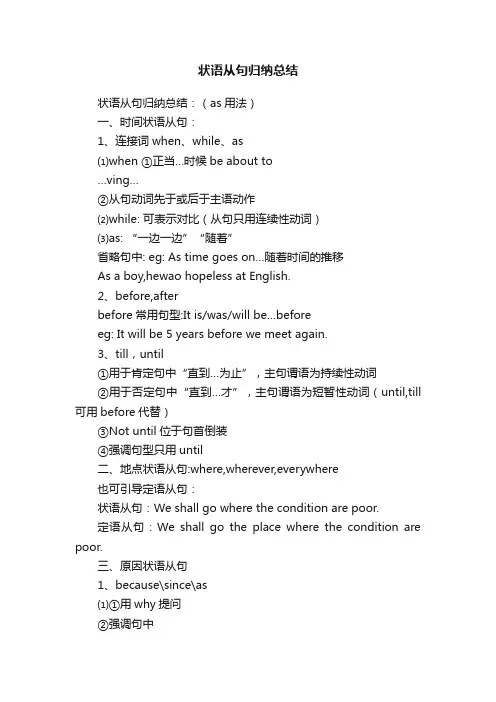
状语从句归纳总结状语从句归纳总结:(as用法)一、时间状语从句:1、连接词when、while、as⑴when ①正当…时候be about to…ving…②从句动词先于或后于主语动作⑵while: 可表示对比(从句只用连续性动词)⑶as: “一边一边”“随着”省略句中: eg: As time goes on…随着时间的推移As a boy,hewao hopeless at English.2、before,afterbefore常用句型:It is/was/will be…beforeeg: It will be 5 years before we meet again.3、till,until①用于肯定句中“直到…为止”,主句谓语为持续性动词②用于否定句中“直到…才”,主句谓语为短暂性动词(until,till 可用before代替)③Not until位于句首倒装④强调句型只用until二、地点状语从句:where,wherever,everywhere也可引导定语从句:状语从句:We shall go where the condition are poor.定语从句:We shall go the place where the condition are poor.三、原因状语从句1、because\since\as⑴①用why提问②强调句中③关联词“not…but”④与“just”等副词连用eg:You shouldn’t any only because you had much.⑵since引导从句常放句首,往往表示对方已知的让步原因关系,主从时态一般相同⑶as从句放句首2、now(that) 既然3、considering that,seeing (that):与since,now that意相近: “鉴于…”“考虑到…”4、not that…,but that…“不是因为…而是因为…”四、目的状语从句1、that,so that,in order that“为了,以便”⑴从句中往往出现情态动词:can\could\may\might⑵当主从句的主语一致时,可转换为相应动词不定式结构:so as to\in order to2、in case,for fear that,lest“以防、以免、万一..”从句是肯定句五、结果状语从句1、so,that,so thatso that可以引导结果状语从句和目的状语从句,区别在于:目的状从中有情动(结果状从前有“,”号)2、so…thatsuch a\an +形+单名=so+形+a\an+单名“如此…以至于”3、such…thatsuch…that(状从)such…as(定从)4、such that (是这样…以致)六、条件状语从句:主句中用一般将来时,从句中用一般现在时或一般过去时1、if正面条件“如果”2、unless. 反面条件=if not 主句为否定意味,从句为肯定句(从句也可用否定结构)unless做介词“除非,如果不”3、so\as long as,on condition that “条件是…”“只要..”4、in case既可引导目的状,又可引导条件状=”if it happened that…”5、providing,provided that, suppsing,suppose (that),given (that) “如果,只要,假如”七、方式状语从句1、as,just as“如…”“正如…一样”Do just as you like2、as if, as though (虚拟语气)八、比较状语从句1、as…as,the same as. 否定句用not so\as…as,not the same as从句中常用省略句: eg:He runs as fast as he can.2、than3、the more…the more…“越…越…”4、more than九、让步状语从句1、although,though.句中不出现but,可出现still\yet(副词)though的位置较灵活,可倒装2、even if,even though“即使”even if表主观,时态往往用于将来even though通常表客观上的,往往表过去事实3、no matter wh…只用于让步状语从句wh..ever 让步状从/名词性从句4、as特殊倒状5、while,whereas突出对比6、if(=even if) 强调部分(n.\adj.\adv.\v.) +as+主+谓(可以是情动)。
初中英语状语从句知识点总结归纳
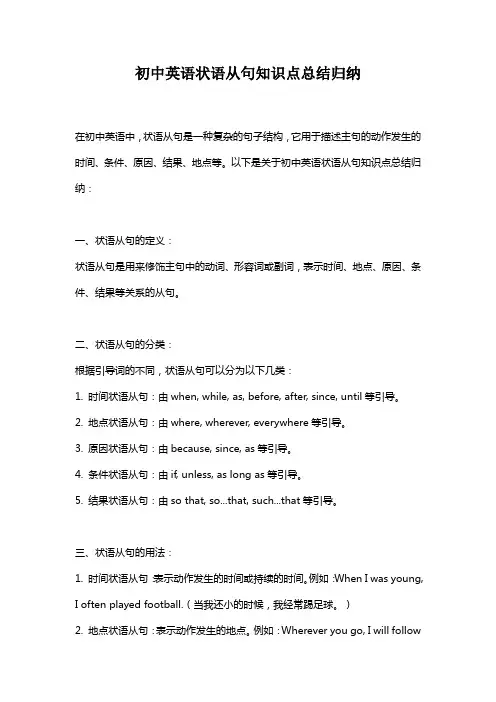
初中英语状语从句知识点总结归纳在初中英语中,状语从句是一种复杂的句子结构,它用于描述主句的动作发生的时间、条件、原因、结果、地点等。
以下是关于初中英语状语从句知识点总结归纳:一、状语从句的定义:状语从句是用来修饰主句中的动词、形容词或副词,表示时间、地点、原因、条件、结果等关系的从句。
二、状语从句的分类:根据引导词的不同,状语从句可以分为以下几类:1. 时间状语从句:由when, while, as, before, after, since, until等引导。
2. 地点状语从句:由where, wherever, everywhere等引导。
3. 原因状语从句:由because, since, as等引导。
4. 条件状语从句:由if, unless, as long as等引导。
5. 结果状语从句:由so that, so...that, such...that等引导。
三、状语从句的用法:1. 时间状语从句:表示动作发生的时间或持续的时间。
例如:When I was young,I often played football.(当我还小的时候,我经常踢足球。
)2. 地点状语从句:表示动作发生的地点。
例如:Wherever you go, I will followyou.(无论你去哪里,我都会跟着你。
)3. 原因状语从句:表示动作发生的原因。
例如:As it was raining, we had to stay indoors.(因为下雨了,我们不得不呆在室内。
)4. 条件状语从句:表示动作发生的条件。
例如:If it snows tomorrow, we will not go out.(如果明天下雪,我们就不出去了。
)5. 结果状语从句:表示动作发生的结果。
例如:She worked hard so that she could pass the exam.(她努力学习以便能通过考试。
状语从句知识点大总结
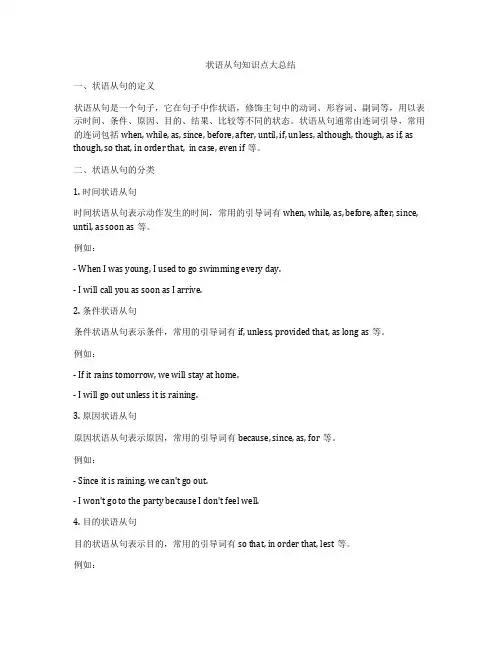
状语从句知识点大总结一、状语从句的定义状语从句是一个句子,它在句子中作状语,修饰主句中的动词、形容词、副词等,用以表示时间、条件、原因、目的、结果、比较等不同的状态。
状语从句通常由连词引导,常用的连词包括when, while, as, since, before, after, until, if, unless, although, though, as if, as though, so that, in order that, in case, even if等。
二、状语从句的分类1. 时间状语从句时间状语从句表示动作发生的时间,常用的引导词有when, while, as, before, after, since, until, as soon as等。
例如:- When I was young, I used to go swimming every day.- I will call you as soon as I arrive.2. 条件状语从句条件状语从句表示条件,常用的引导词有if, unless, provided that, as long as等。
例如:- If it rains tomorrow, we will stay at home.- I will go out unless it is raining.3. 原因状语从句原因状语从句表示原因,常用的引导词有because, since, as, for等。
例如:- Since it is raining, we can't go out.- I won't go to the party because I don't feel well.4. 目的状语从句目的状语从句表示目的,常用的引导词有so that, in order that, lest等。
例如:- I study hard so that I can get a good job.- We left early in order that we might avoid the traffic.5. 结果状语从句结果状语从句表示结果,常用的引导词有so...that, such...that等。
初中状语从句知识点总结
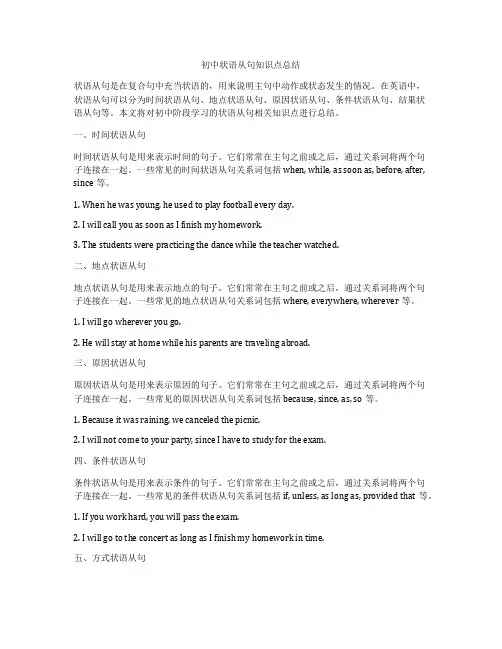
初中状语从句知识点总结状语从句是在复合句中充当状语的,用来说明主句中动作或状态发生的情况。
在英语中,状语从句可以分为时间状语从句、地点状语从句、原因状语从句、条件状语从句、结果状语从句等。
本文将对初中阶段学习的状语从句相关知识点进行总结。
一、时间状语从句时间状语从句是用来表示时间的句子。
它们常常在主句之前或之后,通过关系词将两个句子连接在一起。
一些常见的时间状语从句关系词包括when, while, as soon as, before, after, since等。
1. When he was young, he used to play football every day.2. I will call you as soon as I finish my homework.3. The students were practicing the dance while the teacher watched.二、地点状语从句地点状语从句是用来表示地点的句子。
它们常常在主句之前或之后,通过关系词将两个句子连接在一起。
一些常见的地点状语从句关系词包括where, everywhere, wherever等。
1. I will go wherever you go.2. He will stay at home while his parents are traveling abroad.三、原因状语从句原因状语从句是用来表示原因的句子。
它们常常在主句之前或之后,通过关系词将两个句子连接在一起。
一些常见的原因状语从句关系词包括because, since, as, so等。
1. Because it was raining, we canceled the picnic.2. I will not come to your party, since I have to study for the exam.四、条件状语从句条件状语从句是用来表示条件的句子。
初中英语知识点归纳状语从句的分类和用法
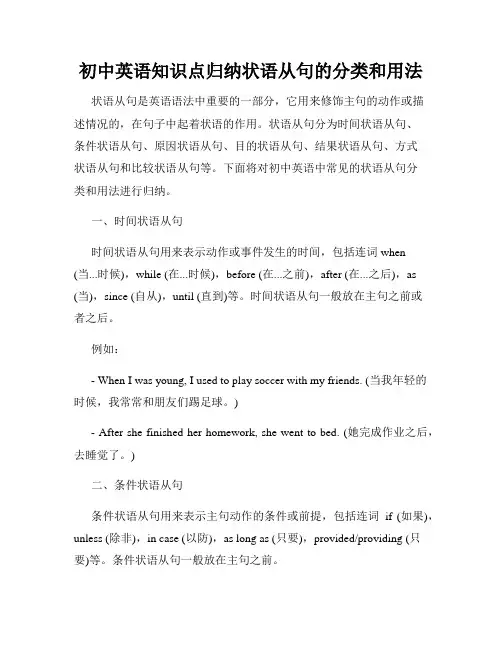
初中英语知识点归纳状语从句的分类和用法状语从句是英语语法中重要的一部分,它用来修饰主句的动作或描述情况的,在句子中起着状语的作用。
状语从句分为时间状语从句、条件状语从句、原因状语从句、目的状语从句、结果状语从句、方式状语从句和比较状语从句等。
下面将对初中英语中常见的状语从句分类和用法进行归纳。
一、时间状语从句时间状语从句用来表示动作或事件发生的时间,包括连词when (当...时候),while (在...时候),before (在...之前),after (在...之后),as (当),since (自从),until (直到)等。
时间状语从句一般放在主句之前或者之后。
例如:- When I was young, I used to play soccer with my friends. (当我年轻的时候,我常常和朋友们踢足球。
)- After she finished her homework, she went to bed. (她完成作业之后,去睡觉了。
)二、条件状语从句条件状语从句用来表示主句动作的条件或前提,包括连词if (如果),unless (除非),in case (以防),as long as (只要),provided/providing (只要)等。
条件状语从句一般放在主句之前。
例如:- If it rains tomorrow, we will stay at home. (如果明天下雨,我们就在家呆着。
)- Unless you work hard, you won't pass the exam. (除非你努力学习,否则你就不能通过考试。
)三、原因状语从句原因状语从句用来表示主句动作或情况的原因,包括连词because (因为),as (因为),since (因为),for (因为),now that (既然)等。
原因状语从句一般放在主句之前。
例如:- Because it was raining, we stayed at home. (因为下雨,我们呆在家里。
初中英语状语从句知识点总结
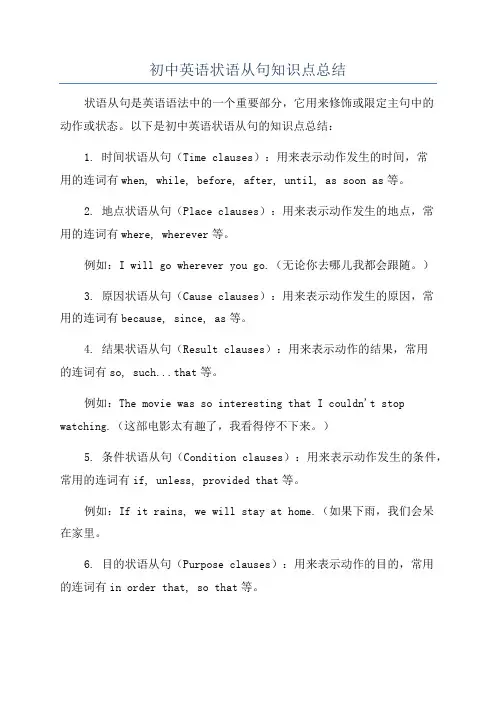
初中英语状语从句知识点总结状语从句是英语语法中的一个重要部分,它用来修饰或限定主句中的动作或状态。
以下是初中英语状语从句的知识点总结:1. 时间状语从句(Time clauses):用来表示动作发生的时间,常用的连词有when, while, before, after, until, as soon as等。
2. 地点状语从句(Place clauses):用来表示动作发生的地点,常用的连词有where, wherever等。
例如:I will go wherever you go.(无论你去哪儿我都会跟随。
)3. 原因状语从句(Cause clauses):用来表示动作发生的原因,常用的连词有because, since, as等。
4. 结果状语从句(Result clauses):用来表示动作的结果,常用的连词有so, such...that等。
例如:The movie was so interesting that I couldn't stop watching.(这部电影太有趣了,我看得停不下来。
)5. 条件状语从句(Condition clauses):用来表示动作发生的条件,常用的连词有if, unless, provided that等。
例如:If it rains, we will stay at home.(如果下雨,我们会呆在家里。
6. 目的状语从句(Purpose clauses):用来表示动作的目的,常用的连词有in order that, so that等。
例如:I bought a new notebook so that I can take notes in class.(我买了一个新笔记本,这样我可以在课堂上记笔记。
)7. 方式状语从句(Manner clauses):用来表示动作发生的方式,常用的连词有as, as if, as though等。
例如:He speaks as if he knows everything.(他说话的样子就像他什么都知道。
状语从句的用法归纳总结
状语从句的用法归纳总结状语从句是指在主句中作状语的从句,用于修饰主句的动作或状态,包括时间、地点、原因、条件、方式、结果等方面。
以下是状语从句的用法归纳总结:1. 时间状语从句:用于表示主句所描述的动作或状态发生的时间,常见的引导词有when,while,as,before,after,until等。
例如:When I went to Paris, I visited the Louvre Museum.As I was walking to the store, I met my old friend.2. 地点状语从句:用于表示主句所描述的动作或状态发生的地点,常见的引导词有where,wherever等。
例如:Where there is a will, there is a way.You can go wherever you want.3. 原因状语从句:用于表示主句所描述的动作或状态的原因,常见的引导词有because,since,as,now that等。
例如:Because it was raining, I stayed home.Since I have time, I will help you.4. 条件状语从句:用于表示主句所描述的动作或状态的条件,常见的引导词有if,unless,provided that,as long as等。
例如:If you work hard, you will succeed.Unless you hurry, we will miss the bus.5. 方式状语从句:用于表示主句所描述的动作或状态的方式,常见的引导词有as,as if,as though等。
例如:He plays guitar as if he were a professional.I will do it as you told me.6. 结果状语从句:用于表示主句所描述的动作或状态的结果,常见的引导词有so that,such that等。
状语从句知识点总结
状语从句知识点总结状语从句是复合句中的一种从句,它在句子中作状语,用来修饰动词、形容词、副词或整个句子,从而表示时间、地点、原因、条件、目的、方式等不同的语义关系。
状语从句在英语语法中占据重要地位,因此我们有必要对状语从句的知识点进行总结和学习。
一、时间状语从句。
时间状语从句用来表示主句动作发生的时间,常见的引导词有when, while, as, before, after, since, until等。
例如,I will call you when I arrive.二、地点状语从句。
地点状语从句用来表示主句动作发生的地点,常见的引导词有where, wherever 等。
例如,I will meet you where we first met.三、原因状语从句。
原因状语从句用来表示主句动作的原因,常见的引导词有because, since, as, for 等。
例如,I didn't go to work because I was sick.四、条件状语从句。
条件状语从句用来表示主句动作发生的条件,常见的引导词有if, unless, as long as等。
例如,If it rains, we will stay at home.五、目的状语从句。
目的状语从句用来表示主句动作的目的,常见的引导词有so that, in order that 等。
例如,I study hard so that I can pass the exam.六、方式状语从句。
方式状语从句用来表示主句动作的方式,常见的引导词有as, as if, as though等。
例如,He speaks as if he were a native speaker.七、让步状语从句。
让步状语从句用来表示与主句动作相反的情况,常见的引导词有though, although, even though, while, whereas等。
状语从句用法总结计划完整
一、时间状语从句时间状语从句用来表示时间关系,常由连词“当……时候”、“随着”、“一旦”、“随时”、“直到”、“自从”等引导。
例如:1.当我在家里的时候,我妈妈总是在旁边看着我。
2.随着天气的转暖,我们就可以去郊游了。
3.一旦你有了问题,就可以找我帮忙。
4.随时都可以来找我,我随时都在。
5.直到你完成这个任务,我才会离开。
6.自从我来到这个城市,我就没有回过家。
二、地点状语从句地点状语从句用来表示地点关系,常由连词“在……地方”、“位于”、“从……起”、“直至”等引导。
例如:1.在这个超市里,你可以找到各种各样的商品。
2.位于市中心的位置,使得这个商场非常繁华。
3.从这家公司起,我们的合作就一直非常好。
4.直至你找到工作,你就可以安心了。
三、原因状语从句原因状语从句用来表示原因关系,常由连词“因为”、“由于”、“鉴于”等引导。
例如:1.因为我今天不舒服,所以我不想去上课。
2.由于天气的原因,我们取消了郊游计划。
3.鉴于你的表现,老师给了你很高的评价。
四、条件状语从句条件状语从句用来表示条件关系,常由连词“如果”、“只要”、“除非”、“只要……就”等引导。
例如:1.如果明天不下雨,我们就去郊游。
2.只要你能努力,你一定能成功。
3.除非你道歉,否则我不会原谅你。
4.只要你想明白,你就会知道我为什么这样做。
五、目的状语从句目的状语从句用来表示目的关系,常由连词“为了”、“以便”、“好”等引导。
例如:1.为了能更好地学习,他每天都很努力。
2.以便你能理解,我解释得很详细。
3.好让你明白,我特意给你举个例子。
六、结果状语从句结果状语从句用来表示结果关系,常由连词“所以”、“因此”、“结果”、“从而”等引导。
例如:1.所以他没能来,因为他生病了。
2.因此我们决定,明天再去郊游。
3.结果这个方法很有效,我们很快就完成了任务。
4.从而使我们的工作更加顺利。
一、时间状语从句时间状语从句用来表示时间关系,常由连词“当……时候”、“随着”、“一旦”、“随时”、“直到”、“自从”等引导。
初中英语语法---状语从句小结
初中英语语法---状语从句小结状语从句是一种作状语用的从句,修饰主句的动词、形容词、副词或修饰全句,补充说明时间、地点、原因、条件、方式、程度、状态等。
根据它表达的意思的不同,可分为时间状语从句、地点状语从句、原因状语从句、条件状语从句、比较状语从句、目的状语从句、结果状语从句等。
时间状语从句、条件状语从句、结果状语从句、原因状语从句都是中考的重点。
一、时间状语从句时间状语从句表示主句动作发生的时间,引导时间状语从句的连词有when,as, while,before, after, as soon as,till,until,since等。
ﻫuntil用于肯定句中,表示句子的动作一直持续到until短语所表示的时间为止,即表示动作的终点。
一般可译为“直到……时(为止)”或“在……以前”。
在这种用法中,句子的谓语动词必须是持续动词(非瞬间动词),如live, wait, last,love,like, stay,work, contin ue等。
until用于否定句中,表示句子的动作直到until短语所表示的时间才开始发生,即表示动作的起点。
一般译为“直到……才”或“直到……之前(……还不)”ﻫeg. It may las tuntil Friday.这可能要延续到星期五。
ﻫ用于否定句中:ﻫeg. The secretwas never tolduntil after the old man's death.ﻫ这个秘密在老人去世后才说出来。
ﻫﻫ连词until以同样的方式分析作连词的until的用法。
作连词用的until的英文释义是uptothe t ime when(直到……时为止)。
ﻫ作连词的until用于肯定句中,表示主句的动作一直持续到从句动作发生或状态出现时为止。
一般可译为“……直到……为止”。
在这种用法中,主句的谓语动词必须是持续动词(非瞬间动词),如live, wait ,last, love, like, stay,w ork, continue 等。
- 1、下载文档前请自行甄别文档内容的完整性,平台不提供额外的编辑、内容补充、找答案等附加服务。
- 2、"仅部分预览"的文档,不可在线预览部分如存在完整性等问题,可反馈申请退款(可完整预览的文档不适用该条件!)。
- 3、如文档侵犯您的权益,请联系客服反馈,我们会尽快为您处理(人工客服工作时间:9:00-18:30)。
初中英语语法--- 状语从句小结状语从句是一种作状语用的从句,修饰主句的动词、形容词、副词或修饰全句,补充说明时间、地点、原因、条件、方式、程度、状态等。
根据它表达的意思的不同,可分为时间状语从句、地点状语从句、原因状语从句、条件状语从句、比较状语从句、目的状语从句、结果状语从句等。
时间状语从句、条件状语从句、结果状语从句、原因状语从句都是中考的重点。
一、时间状语从句时间状语从句表示主句动作发生的时间,引导时间状语从句的连词有when, as, while, before, after, as soon as, till, until, sinc等。
until 用于肯定句中,表示句子的动作一直持续到until 短语所表示的时间为止,即表示动作的终点。
一般可译为直到……时(为止)'或在……以前”在这种用法中,句子的谓语动词必须是持续动词(非瞬间动词),女口live, wait, last, love, like, stay, work, continue等。
until 用于否定句中,表示句子的动作直到until 短语所表示的时间才开始发生,即表示动作的起点。
一般译为直到……才”或直到……之前(……还不)”eg. It may last until Friday. 这可能要延续到星期五。
用于否定句中:eg. The secret was never told until after the old man's death.这个秘密在老人去世后才说出来。
连词until以同样的方式分析作连词的until 的用法。
作连词用的until 的英文释义是up to the time whe n(直到............. 时为止)。
作连词的until 用于肯定句中,表示主句的动作一直持续到从句动作发生或状态出现时为止。
一般可译为“••…直到……为止”在这种用法中,主句的谓语动词必须是持续动词(非瞬间动词),如live, wait , last, love, like, stay, work, continue 等。
eg. Heat can be conducted from a hot body to a cooler one until both are at the same temperature.热可以从一个热的物体传到一个较冷的物体,直到两者温度相同为止。
作连词的until 用于否定句中, 表示主句的动作在从句的动作发生之前尚未发生,或者说主句的动作在从句的动作发生之后才开始。
一般可译为“直到……才”。
eg. I hadn't realized she was foreign until she spoke. 她不说话我还一直不知道她是个外国人。
si nee作连词引导时间状语从句的用法:一、若since 引导的状语从句的谓语动词是终止性的过去时,则从句表示的时间是“从动作开始的那一时刻起”。
如:eg. He has studied very hard since he came to our school. 自从他来到我们学校,他学习就非常努力。
二、若since引导的状语从句的谓语动词是持续性动词或表示状态的动词的过去时时,则从句表示的时间是“从那持续动作或状态结束时算起”。
eg. I haven't heard any noise since I slept.Sleep为持续性动词,sleep的动作结束时,即醒来”时,这句应译为我醒后还未听到任何声音”。
John is now with his parents in New York, it is already three years since he was a teacher. 约翰现在和父母一起住在纽约,他不当教师已经三年了。
while表示正当…… 时”(指同时)用于同时进行的两延续性动作相伴随而发生,常对同类的两动作进行对比。
eg. Please write while I read. 我念的时候,请写下来。
when 表示“当……. 时:可表示瞬间、时间段,与主从句所述动作、事情可同时,也可有先后。
例:eg. It was snowing when we got to the airport. 我们到达机场时,天正下着雪。
(同时发生)。
as 当…时,强调at the same time①不指先后,而指同时发生,尤指短动作或事件同时发生,eg. I looked; some one came here正当我看的时候,有个人走过来。
②as不可说明两种正在发展或变化的情况。
eg. As I get older, I get more optimistic. 随着年龄变大我变得更加乐观。
as、when、while 都可引导时间较长的同时发生的“背景”情况。
eg. As (when, while) I was walking down the street, I noticed a police car in front of a shop.当我顺着马路往前走的时候,我发现一家商店前停着一辆警车。
注意:1.在以as soon as, until, when等引导的时间状语从句中,通常用一般现在时,而主句用将来时。
2. since引导的时间状语从句用一般过去时,主句常用完成时,并且动词用延续性动词。
二、条件状语从句条件状语从句表示主句动作发出的前提或条件、假想、推测等,条件状语从句通常由连词if, uni ess等引导。
eg. I'll help you with your English if I am free tomorrow. 如果我明天有空,我就帮你学英语。
He won't be late unless he is ill. 他不会迟到的,除非他生病了。
注意:在if, uni ess等词引导的条件状语从句,主句的谓语动词用一般将来时,从句的谓语动词通常用一般现在时表示将来的含义。
三、目的状语从句目的状语从句表示主句的动作发生的目的或愿望,可用so that, that,in order that等词引导。
目的状语动词中常有情态动词may/might, can/could, should或will/would.eg. He visited London in order that he could see his parents.=He visited London so that he could see his pare nts 为了看望父母他来到了伦敦。
School was closed early in order that the childre n might get home ahead of the storm .学校早放学,为的是让孩子们在暴风雨前到家。
四、结果状语从句结果状语从句表示主句的动作所引起的结果,可以用so…that,such …that等引导。
eg. The burglar wore gloves, so that there were no fin gerpri nts found 窃贼带着手套,所以没有发现指纹。
He spoke so quickly that only a few students could follow him. 他讲话太快,只有几个学生能听懂。
The house is so expensive that very few people can afford it. 房子价格太贵,很少有人买得起。
He was so good a runner that no body could catch him他是跑步的能手,没人能赶上他。
It is such a good cha nee that we must n't miss it.如此好的机会我们绝不能错过。
It is such nice weather that I don't like to stay at home.天气这么好,我不愿呆在家里。
辨析:so…that和such…thatso…that和such…that的意思均为如此... 以致.... ”,都用来引导结果状语从句。
但二者用法不尽相同,现归纳如下:1. so…that结构中的so为副词,后面跟形容词或副词;such…that中的such为形容词,后面接名词(名词前可以有形容词修饰)。
eg. He became so angry that he could n't speak .他变得很生气,以致说不出话来。
It was such a fine day that we went out for a walk. 那是一个很晴朗的日子,我们出去散步。
2. 当that前的名词有表示数量多少的many, much, few, little等修饰时,只能用so,不能用such.eg. There was so much noise outside that we couldn't hear the teacher. 外面嘈杂声很大,以致我们不能听到老师的话。
He had so many falls that he was black and blue all over.他跌了这么多的跤,以致全身青一块、紫一块的。
注意:若名词前的little 解释为“小(的)”意思时,则仍用such, 而不能用so.eg. They are such little sheep that they can't run fast. 它们是小绵羊,以至于它们跑得不快。
3. 当that前是单数可数名词且该名词前面有形容词修饰时,so与such可以互换,即:so+ adj.+ a/an+ n. = such+ a/an+ adj.+ n.eg.She is so good a teacher that we all love her.= She is such a good teacher that we all love her她是一位好老师,我们都爱她。
4. 当that前是不可数名词或复数可数名词时,则必须用such,不能用so来代替。
eg. It was such fine weather that they all went swimming. 那是个好天气,他们都去游泳了。
They are such nice apples that we would like to eat the m 它们是如此好的苹果,以致我们想吃它们。
五、原因状语从句原因状语从句由because, as, for, sine等引导。
